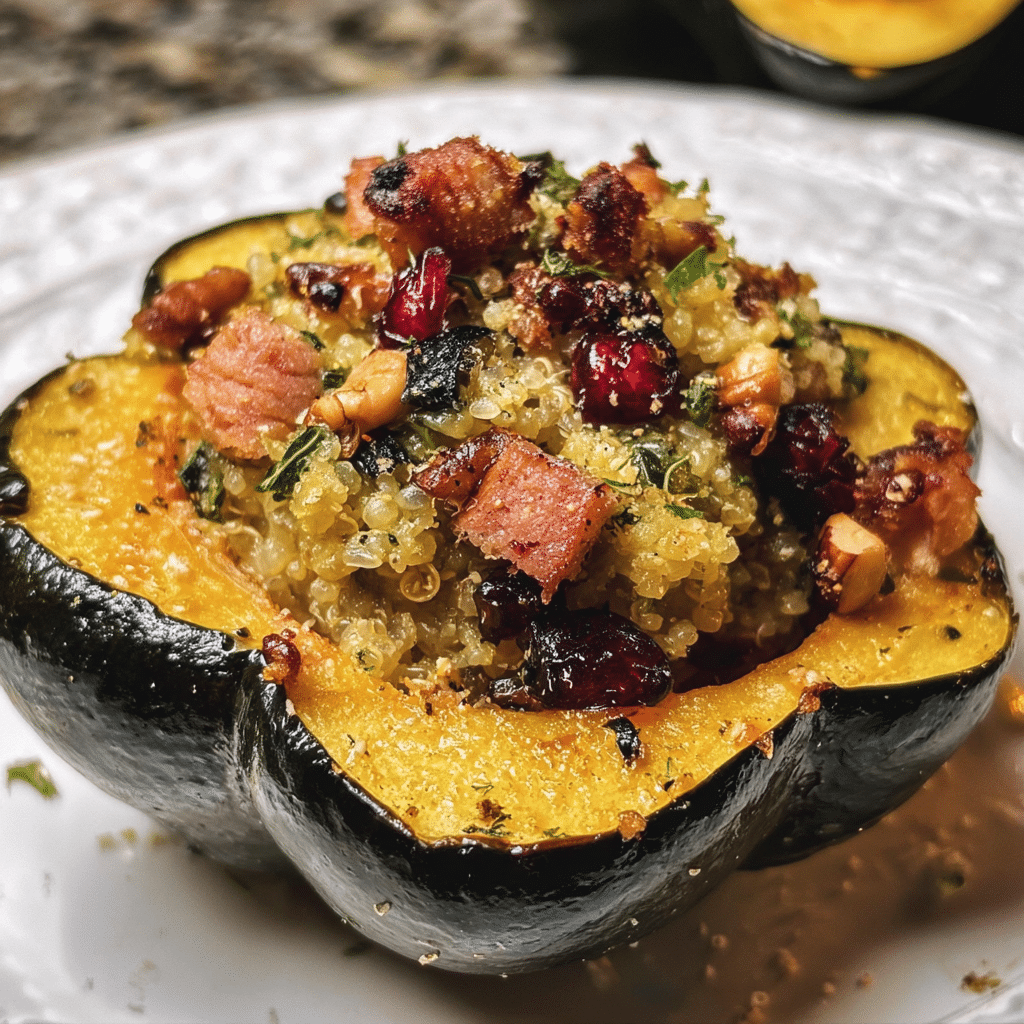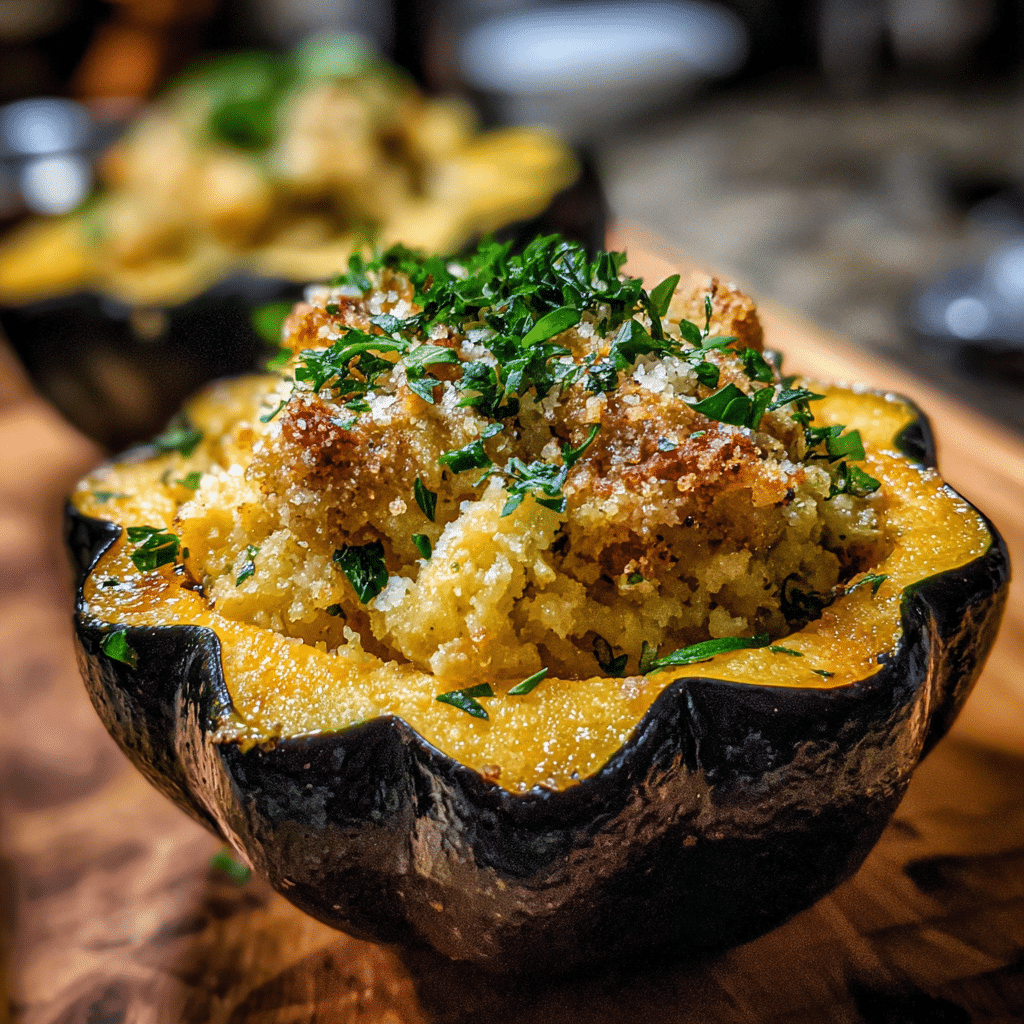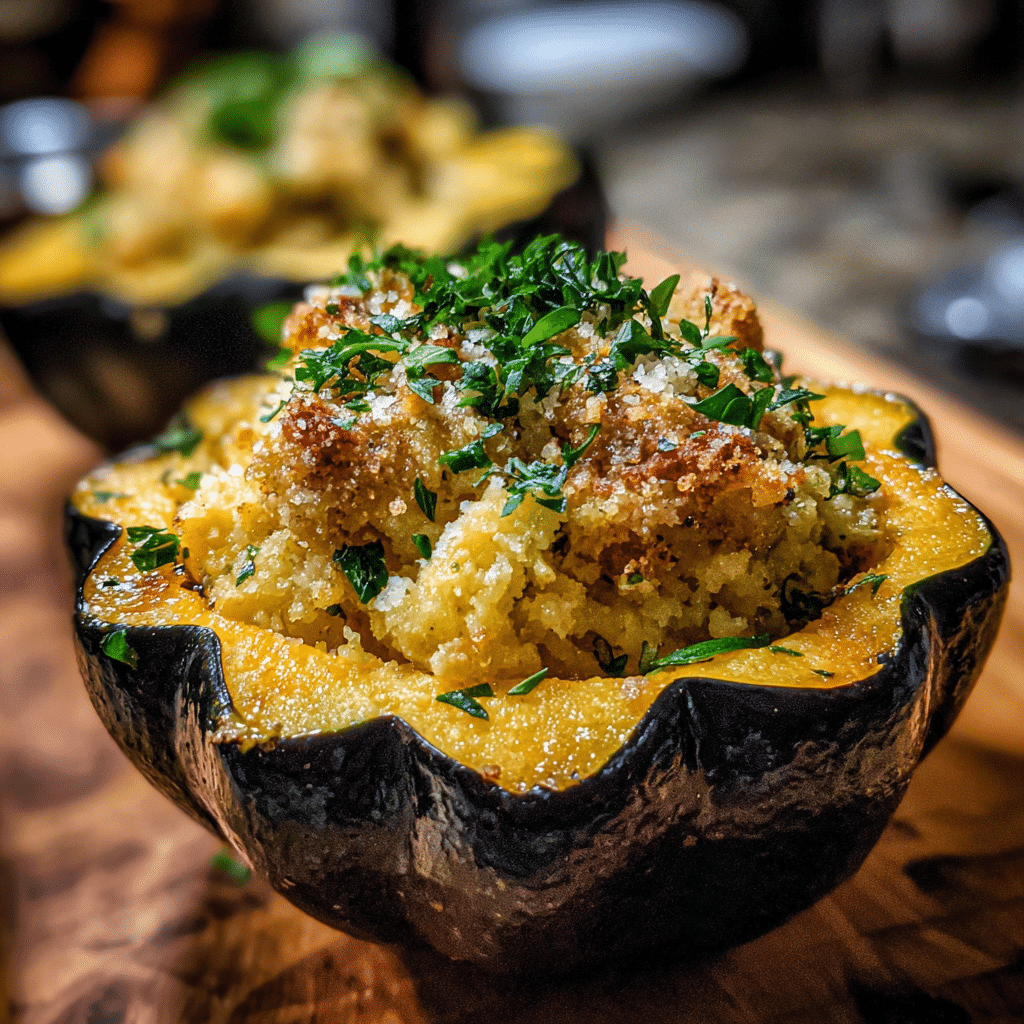Stuffed acorn squash has a way of bringing warmth and comfort into the home, particularly as the leaves begin to turn and autumn settles in. I can vividly remember the first time I encountered this delightful dish. It was during a family gathering at my grandmother’s house, where the kitchen was filled with the rich aromas of spices and roasted vegetables. My grandmother, a culinary wizard in her own right, had filled her acorn squashes with a colorful medley of quinoa, nuts, and cranberries that not only looked exquisite but tasted divine. As I took my first bite, I was struck by how the sweetness of the squash complemented the savory filling, creating a harmonious blend that danced on my palate. From that moment on, stuffed acorn squash became a staple in my own kitchen, a dish that I would return to time and time again.

The Story Behind This Recipe
My journey with stuffed acorn squash has been more than just a love affair with a delicious recipe; it has been a conduit for family bonding, creativity, and even a bit of nostalgia. Each time I prepare it, I find myself reminiscing about my grandmother’s warm kitchen, the laughter of family members, and the shared traditions that tie us all together. As I chop vegetables and stir together my filling, I often think about the importance of such recipes in our lives—they connect us to our past while allowing us to express ourselves in the present. Stuffed acorn squash is not just food; it’s a canvas for stories, memories, and creativity.
The origins of stuffed acorn squash are as rich as the flavors within it. Traditionally, stuffed squash dishes can be traced back to Native American cooking, where they utilized the bountiful harvest of squash, corn, and beans. These ingredients, known as the “Three Sisters,” were often combined in various ways, showcasing the agricultural abundance of the region. Over the years, the dish has evolved and adapted, incorporating other ingredients based on availability and regional preferences. What excites me about stuffed acorn squash is its versatility; it can be tailored to fit any dietary preference or flavor profile, making it a wonderful addition to any dinner table.
In today’s fast-paced world, stuffed acorn squash serves as a practical solution for busy families. Not only is it quick to prepare, but it can also be made in advance and reheated, making it an ideal choice for weeknight dinners. The fact that it’s a one-dish meal means less time spent cleaning up, allowing families to spend more time together. Moreover, stuffed acorn squash is incredibly nutritious, packed with vitamins, minerals, and fiber, which is a bonus for health-conscious families looking to incorporate more wholesome foods into their diets.
Seasonally, stuffed acorn squash shines brightest during the fall months when squash is in abundance. As the air turns crisp, the vibrant colors of autumn vegetables inspire a sense of coziness and comfort. The dish not only reflects the seasonal ingredients available but also carries an emotional weight that resonates with many of us—it’s about gathering, sharing, and savoring the simple pleasures in life. Each time I prepare stuffed acorn squash, I find that it brings my family to the table, encourages conversation, and sparks joy in our hearts.
This guide promises to take you through everything you need to know about stuffed acorn squash—from its rich history and cultural significance to tips on preparing the perfect filling. Whether you’re cooking for a family gathering, a cozy dinner for two, or meal prepping for a busy week, this dish is sure to impress. So, let’s dive into the world of stuffed acorn squash, where tradition meets creativity, and every bite tells a story.
The Rich History and Cultural Significance of stuffed acorn squash
The culinary world is a tapestry woven from diverse traditions, and stuffed acorn squash is a beautiful thread within that fabric. Its history is steeped in the agricultural practices of Native Americans, who revered the acorn squash as a staple crop. The squash is believed to have originated in Central America and made its way to North America through trade and migration. It was one of the first crops cultivated by indigenous peoples, who celebrated its nutritional value and versatility. Over time, stuffed variations emerged as cooks began experimenting with fillings, often using what they had on hand—grains, nuts, meats, and seasonal vegetables.
Origins and History
The practice of stuffing vegetables, particularly squash and gourds, can be traced back centuries. The Native Americans often stuffed their squashes with ingredients like corn and beans, creating a nourishing meal that reflected their agricultural practices. As European settlers arrived, they adopted and adapted these traditions, leading to a delightful fusion of flavors and techniques. Stuffed acorn squash became a popular dish in many homes and was often served during harvest festivals and Thanksgiving gatherings, symbolizing abundance and gratitude.
As the years progressed, variations of stuffed acorn squash began to pop up across different regions and cultures. In New England, for instance, you might find a version filled with sausage, apples, and breadcrumbs, reflecting the local agricultural landscape. Meanwhile, in the American Southwest, cooks may use black beans, corn, and spices, showcasing the influence of Mexican cuisine. This adaptability is what makes stuffed acorn squash so special; it can be a reflection of personal taste, cultural heritage, or even a creative culinary experiment.
Cultural Significance
Stuffed acorn squash has more than just a place in family kitchens; it also carries cultural significance during various celebrations and gatherings. In many cultures, the act of cooking and sharing food symbolizes love, togetherness, and community. Among Native American tribes, the squash is revered as a symbol of sustenance and survival, often featured in storytelling and rituals. Today, stuffed acorn squash is a popular choice for festive occasions, from Thanksgiving feasts to harvest celebrations, serving as both a centerpiece and a conversation starter.
Additionally, renowned chefs and restaurants have embraced stuffed acorn squash, elevating it to gourmet status. Many have introduced innovative fillings and presentation styles, showcasing the dish’s versatility. Chefs have experimented with global flavors, incorporating elements from Mediterranean to Asian cuisines, proving that this humble squash can take on a variety of forms and flavors, making it appealing to a broad audience.
Nutritional Benefits
Beyond its cultural and historical significance, stuffed acorn squash also boasts impressive nutritional benefits. Acorn squash is low in calories yet high in essential nutrients. It contains vitamins A and C, which are crucial for immune function and skin health, as well as potassium, which helps regulate blood pressure. When you stuff the squash with wholesome ingredients like quinoa, nuts, and vegetables, you enhance its nutritional profile even further. You’re not just serving up a delicious dish; you’re also providing a meal that is rich in fiber, protein, and healthy fats.
Moreover, stuffed acorn squash is naturally gluten-free and can be easily adapted to cater to various dietary restrictions, including vegan and vegetarian diets. This makes it an excellent choice for gatherings where guests may have different dietary needs. As someone who loves to entertain, I appreciate how accommodating this dish can be, allowing everyone to enjoy a hearty and satisfying meal together.
In conclusion, stuffed acorn squash is more than just a dish; it is a rich tapestry of history, culture, and nutrition. It invites us to reflect on our roots, celebrate traditions, and create new memories around the dinner table. As we explore this delightful dish further, you will discover the myriad ways to prepare, serve, and enjoy stuffed acorn squash, making it a cherished addition to your culinary repertoire.
Essential Ingredients for Perfect stuffed acorn squash
When it comes to crafting the perfect stuffed acorn squash, the ingredients you choose can make all the difference. Each component not only plays a vital role in flavor but also enhances the dish’s nutritional profile and visual appeal. Below, we’ll dive deep into the essential ingredients that will elevate your stuffed acorn squash to new culinary heights.
Essential Ingredients
- 2 medium-sized acorn squashes – Look for squashes that are firm and heavy for their size, with a deep green color and a few orange streaks. These indicators suggest ripeness and sweetness.
- 1 cup of quinoa (or rice) – Quinoa is a great choice for its nutty flavor and high protein content. If you’re opting for rice, brown rice adds a nice texture and nutritional benefits.
- 1 small onion, diced – Onions provide a foundational flavor that enhances the overall taste of the dish. Choose firm, dry onions without soft spots.
- 2 cloves of garlic, minced – Fresh garlic is a must for adding aroma and a slight kick. Fresh cloves should be firm and free of any mold.
- 1 bell pepper, diced – Any color will do, but red or yellow peppers add a nice sweetness. Look for vibrant, firm peppers without blemishes.
- 1 cup of black beans (canned or cooked) – Black beans add protein and fiber. If using canned, rinse them to reduce sodium content.
- 1 teaspoon of cumin – Cumin adds earthiness. Opt for whole seeds if possible and toast them for deeper flavor.
- Salt and pepper to taste – Freshly ground pepper and sea salt can elevate the dish significantly.
- 1/2 cup of cheese (optional) – Feta or shredded cheddar can add creaminess and flavor. Choose high-quality cheese that melts well.
- Fresh herbs (like parsley or cilantro) – Fresh herbs brighten up the dish. Choose vibrant, fragrant herbs for the best flavor impact.
Each ingredient contributes something unique to the stuffed acorn squash. The acorn squash itself is sweet and nutty, making it an ideal vessel for the savory filling. The quinoa or rice adds a hearty base, while the vegetables bring in color and crunch. Spices like cumin enhance the overall taste, and cheese can add richness if desired.
Print
Stuffed Acorn Squash Recipe
Ingredients
- 1 tablespoon lemon juice
- ¾ cup grated Parmesan cheese
- ½ cup crumbled goat cheese or feta
- 2 medium acorn squash
- 2 tablespoons extra-virgin olive oil, divided
- ½ teaspoon fine sea salt, divided
- ½ cup quinoa, rinsed
- 1 cup water
- ¼ cup dried cranberries
- ¼ cup raw pepitas (hulled pumpkin seeds)
- ¼ cup chopped green onion
- ¼ cup chopped fresh flat-leaf parsley, plus 1 tablespoon for garnish
- 1 clove garlic, pressed or minced
Instructions
- Preheat the oven to 400 degrees Fahrenheit and line a large, rimmed baking sheet with parchment paper for easy clean-up.
- To prepare the squash, use a sharp chef’s knife to slice through it from the tip to the stem. I find it easiest to pierce the squash in the center along a depression line, then cut through the tip, and finish by slicing through the top portion just next to the stem. Use a large spoon to scoop out the seeds and stringy bits inside, and discard those pieces.
- Place the squash halves cut side up on the parchment-lined pan. Drizzle 1 tablespoon of the olive oil over the squash, and sprinkle with ¼ teaspoon of the salt. Rub the oil into the cut sides of the squash, then turn them over so the cut sides are against the pan. Bake until the squash flesh is easily pierced through by a fork, about 30 to 45 minutes. Leave the oven on.
- Meanwhile, cook the quinoa: In a medium saucepan, combine the rinsed quinoa and water. Bring the mixture to a boil over medium-high heat, then reduce the heat as necessary to maintain a gentle simmer. Simmer, uncovered, until all of the water is absorbed, 12 to 18 minutes. Remove the pot from the heat and stir in the cranberries. Cover, and let the mixture steam for 5 minutes. Uncover and fluff the quinoa with a fork.
- In a medium skillet, toast the pepitas over medium heat, stirring frequently, until the pepitas are turning golden on the edges and making little popping noises, about 4 to 5 minutes. Set aside.
- Pour the fluffed quinoa mixture into a medium mixing bowl. Add the toasted pepitas, chopped green onion, parsley, garlic, lemon juice, the remaining ¼ teaspoon salt, and the remaining 1 tablespoon olive oil. Stir until the ingredients are evenly distributed. Taste and add additional salt, if necessary.
- If the mixture is very hot, let it cool for a few minutes before adding the Parmesan cheese and goat cheese. Gently stir the mixture to combine.
- Turn the cooked squash halves over so the cut sides are facing up. Divide the mixture evenly between the squash halves with a large spoon. Return the squash to the oven and bake for 15 to 18 minutes, until the cheesy quinoa is turning golden on top.
- Sprinkle the stuffed squash with the remaining 1 tablespoon chopped parsley, and serve warm.
Shopping Tips
When shopping for these ingredients, consider visiting local farmers’ markets, especially for seasonal items like acorn squash. You’ll often find fresher produce compared to grocery stores. For grains and beans, bulk bins can be a cost-effective way to purchase only what you need. Always check for seasonal produce as it is usually more flavorful and less expensive. Acorn squash is typically in season from late summer to fall, making it the perfect time to experiment with stuffed acorn squash.
For quality indicators, inspect the squashes for any blemishes or soft spots. A fresh squash will feel heavy and have a hard skin. When it comes to quinoa, look for a brand that offers organic options, as this may ensure a higher quality product. If you are choosing canned beans, opt for low-sodium varieties to control salt intake.
Substitutions and Alternatives
There are plenty of substitutions available if you have dietary restrictions. For instance, if you’re avoiding grains, you can use cauliflower rice instead of quinoa or rice for a low-carb option. If you need a vegan recipe, simply omit the cheese or use a plant-based alternative. For a gluten-free version, ensure that your quinoa and any other packaged ingredients are certified gluten-free.
Storage tips are crucial for maximizing freshness. Acorn squash can be stored in a cool, dark place for several weeks. Once cut, wrap it tightly in plastic wrap and refrigerate for up to five days. Quinoa should be stored in an airtight container in a cool, dry place and can last for up to a year. If you have leftover beans, store them in a sealed container in the refrigerator for up to a week.
In terms of cost-saving tips, purchasing dried beans and cooking them yourself can significantly cut costs compared to canned options. Additionally, buying in bulk can save money over time, especially for grains and spices. Remember, cooking is about creativity, and the stuffed acorn squash can be modified based on your budget and what ingredients you have on hand.
Detailed Step-by-Step stuffed acorn squash Cooking Instructions
Creating a delightful stuffed acorn squash dish is as much about the process as it is about the ingredients. This recipe will guide you through each step with detailed instructions, ensuring that your squash turns out perfectly every time.
Preparation Steps
- Preheat your oven: Start by preheating your oven to 400°F (200°C). This temperature is ideal for roasting the acorn squash until tender and caramelized.
- Prepare the acorn squash: Carefully cut the acorn squashes in half lengthwise. Use a spoon to scoop out the seeds and any fibrous strands. This is a great opportunity to get your kids involved; they often find this step fun!
- Season the squash: Brush the inside of each squash half with olive oil and sprinkle with salt and pepper. This step not only enhances the flavor but also helps in caramelization.
- Roast the squash: Place the squash halves cut-side down on a baking sheet lined with parchment paper. Roast in the preheated oven for about 25-30 minutes. You’ll know they’re ready when they’re easily pierced with a fork.
Cooking Process
- Cook the quinoa: While the squash is roasting, rinse 1 cup of quinoa under cold water. This removes any bitterness from the outer coating. Cook it according to package instructions, usually 2 cups of water for every 1 cup of quinoa. Bring to a boil, then reduce to a simmer and cover. Cook until the water is absorbed and the quinoa is fluffy, about 15 minutes.
- Sauté the vegetables: In a large skillet, heat 1 tablespoon of olive oil over medium heat. Add the diced onions and cook until they become translucent, about 5 minutes. Then, add the minced garlic and diced bell pepper, cooking for an additional 3-4 minutes until softened.
- Add the beans and spices: Stir in the black beans, cooked quinoa, and cumin. Mix well and let the filling cook for another 2-3 minutes to heat through. Taste and adjust seasoning with salt and pepper as necessary. If using cheese, fold it in at this stage to allow it to melt and incorporate.
Final Assembly
- Fill the squash: Once the acorn squashes are done roasting, carefully flip them over so the cut side is facing up. Spoon the quinoa and vegetable mixture generously into each half, packing it slightly to ensure they are well filled.
- Return to the oven: Place the filled squash halves back in the oven and bake for another 10-15 minutes. This allows the flavors to meld, and the squash to absorb some of the filling’s moisture, enhancing the overall taste.
- Garnish and serve: Once done, remove from the oven and let them cool for a few minutes. Garnish with freshly chopped herbs such as parsley or cilantro for a burst of color and freshness. Serve warm, and enjoy the delicious blend of flavors that make up your stuffed acorn squash.
Cooking can sometimes feel daunting, but with these detailed steps, you’ll not only conquer stuffed acorn squash but also gain confidence in the kitchen. Remember to enjoy the process, and take your time. Cooking is as much about the journey as it is about the destination. Happy cooking!
Professional Tips and Techniques for stuffed acorn squash
When it comes to creating the perfect stuffed acorn squash, there’s an art and a science that can elevate your dish from simple to spectacular. Whether you’re hosting a dinner party or preparing a cozy meal for yourself, these professional tips and techniques will guide you in crafting a delightful experience that will impress everyone at the table.

Professional Techniques
First, let’s talk about the fundamental techniques that will enhance your stuffed acorn squash. The beauty of this dish lies in the balance of flavors and textures, so choosing the right ingredients is crucial. Start with fresh acorn squash; look for ones that feel heavy for their size and are free of blemishes. A good rule of thumb is to choose squash that has a rich, deep green color with a hint of orange; this indicates ripeness and flavor.
When it comes to cooking, roasting the acorn squash is the preferred method. Preheat your oven to 400°F (200°C). Cut the squash in half lengthwise and scoop out the seeds. Brush the insides with olive oil and sprinkle with salt and pepper. This simple step will enhance the natural sweetness of the squash. Roast them cut-side down on a baking sheet lined with parchment paper for about 25-30 minutes, or until they are tender and caramelized.
For the stuffing, consider sautéing your vegetables first. This not only adds depth to your stuffing but also ensures that the ingredients are cooked evenly. Onions, garlic, and celery are classic choices, but don’t hesitate to throw in some mushrooms or spinach for added flavor and nutrition. If you’re using grains or legumes, make sure they are pre-cooked before mixing them with your sautéed vegetables.
Troubleshooting Guide
Even the most experienced cooks face challenges in the kitchen, so here’s a troubleshooting guide for common issues you might encounter when preparing stuffed acorn squash.
Problem: The squash is too hard to cut.
Solution: If you find your acorn squash challenging to slice, try microwaving it for a couple of minutes. This will soften the skin slightly, making it easier to cut.
Problem: The stuffing is too dry.
Solution: To avoid dryness, consider adding a splash of vegetable broth or a drizzle of olive oil to your stuffing mixture. This will keep the flavors vibrant and moist.
Problem: The squash is not cooked through.
Solution: If you find that your acorn squash is still firm after the suggested roasting time, simply cover it with foil and return it to the oven for an additional 10-15 minutes.
These tips can save a dish that might otherwise fall flat and ensure your stuffed acorn squash is a hit.
Presentation Tips
Presentation is key when serving any dish, and stuffed acorn squash offers an opportunity for beautiful plating. Once your squash is roasted and stuffed, consider garnishing it with fresh herbs such as parsley or thyme for a pop of color. A sprinkle of pomegranate seeds can add a festive touch, particularly during the fall and winter months.
Additionally, consider the plate you choose. A rustic wooden board or a simple white plate can create a striking contrast against the vibrant hues of the squash and its stuffing. Serve with a side of leafy greens drizzled in a light vinaigrette to create a balanced meal that is visually appealing.
When it comes to beverage pairings, a crisp white wine, such as Sauvignon Blanc or a lightly oaked Chardonnay, can complement the sweetness of the squash beautifully. Alternatively, if you prefer a non-alcoholic option, try a sparkling apple cider or a herbal iced tea.
Lastly, don’t forget to share stories about the dish as you serve it. Mention how you discovered your favorite stuffing combination or the first time you made stuffed acorn squash. Personal anecdotes can transform a simple meal into a cherished memory.
Creative Variations and Adaptations of stuffed acorn squash
One of the most exciting aspects of cooking is the ability to experiment and adapt recipes to your taste. This holds true for stuffed acorn squash as well. With a little creativity, you can transform this dish into countless variations that cater to different palates or dietary needs.
Seasonal Variations
Seasonal ingredients can play a significant role in evolving your stuffed acorn squash recipe. In the fall, consider incorporating hearty grains such as farro or quinoa, tossed with roasted Brussels sprouts and cranberries for a festive touch. As winter approaches, think about using root vegetables like parsnips or carrots in your stuffing, adding warmth and comfort to the dish.
In the spring, swap in fresh herbs like basil or dill, and mix in asparagus or peas to bring a light, refreshing quality to your stuffing. Summer lends itself beautifully to Mediterranean flavors, such as feta cheese, olives, and sun-dried tomatoes, giving your acorn squash a bright, sunny taste.
Dietary Adaptations
For those looking to modify their stuffed acorn squash for dietary restrictions, there are plenty of options. If you’re going vegan, replace cheese with nutritional yeast for a cheesy flavor without the dairy. For a gluten-free option, use gluten-free breadcrumbs or skip the breadcrumbs entirely and opt for a grain-based stuffing with rice or quinoa.
For those following a keto diet, focus on high-protein, low-carb ingredients. Instead of traditional grains, consider using crumbled sausage or ground turkey combined with sautéed spinach and cream cheese for a rich, filling stuffing. Adjusting the spice level is also vital; if you enjoy heat, add some crushed red pepper flakes or diced jalapeños to your mixture.
Creative Twists
Adding a touch of international flair can elevate your stuffed acorn squash experience. Consider an Italian twist by using a stuffing of risotto and marinara sauce, topped with mozzarella cheese that melts beautifully. For a Mexican-inspired version, fill the squash with a mixture of black beans, corn, diced tomatoes, and spices like cumin and chili powder, garnished with avocado or cilantro.
Another fun idea is to use different cooking methods. While roasting is the classic approach, try making your stuffed acorn squash in a slow cooker. It allows the flavors to meld beautifully over a longer cooking period, resulting in a tender and flavorful dish. Alternatively, you can also grill the squash for a smoky flavor and an added depth that’s perfect for summer barbecues.
If you find yourself with leftovers, don’t fret! The stuffing can be repurposed in various ways. Mix it with scrambled eggs for a delicious breakfast, or fold it into a quesadilla for a quick lunch. You can even turn the leftover squash into a creamy soup by blending it with vegetable stock and seasonings for a comforting meal.
With these creative variations and adaptations, your journey with stuffed acorn squash will be both rewarding and delicious. Embrace the seasons, cater to dietary needs, and let your imagination run wild!
Storage, Reheating, and Meal Prep for stuffed acorn squash
When it comes to preparing a delicious meal of stuffed acorn squash, understanding the best storage, reheating methods, and meal prep strategies can elevate your cooking experience. Whether you’re making this dish for a special occasion or just for a weeknight family dinner, knowing how to store and reheat it properly will help you enjoy your culinary creation to the fullest. Let’s dive into the details!
Short-term Storage
After you’ve prepared your stuffed acorn squash, you might be wondering how to store the leftovers for maximum freshness. If you plan to enjoy your stuffed acorn squash within a couple of days, the refrigerator is your best bet. First, allow the dish to cool completely at room temperature. This is crucial because placing hot food directly into the refrigerator can raise the internal temperature, potentially compromising food safety.
Once cooled, transfer the stuffed acorn squash into an airtight container. If you’ve prepared individual servings, consider using meal prep containers that allow you to separate each portion easily. This not only makes it convenient for reheating but also helps in maintaining the freshness of each serving. Generally, stuffed acorn squash can be stored in the refrigerator for about 3 to 5 days.
For an added layer of protection against moisture and odors, you can wrap the squash in plastic wrap or aluminum foil before placing it in the container. This is particularly useful if you have other strong-smelling foods in the fridge that might affect the flavor of your dish.
Freezing and Long-term Storage
If you want to store your stuffed acorn squash for a longer period, freezing is a viable option. Freezing helps preserve the flavors and textures, allowing you to enjoy your dish months later. To freeze, first, ensure that the stuffed acorn squash is completely cooled, just as with refrigerator storage. Then, wrap each stuffed half of acorn squash tightly in plastic wrap. This is important to prevent freezer burn, which can ruin the texture and taste.
Next, place the wrapped squash halves in a freezer-safe bag or container. Make sure to label the bag or container with the date so you can keep track of how long it has been stored. Generally, stuffed acorn squash can be frozen for up to 3 months. Beyond this timeframe, the taste and texture may begin to decline even though it might still be safe to eat.
When you’re ready to enjoy your frozen stuffed acorn squash, the best way to thaw it is in the refrigerator overnight. This slow thawing process helps maintain the quality of the dish. If you’re short on time, you can also use the microwave’s defrost setting, but be cautious. Microwaving can create uneven heating, leading to some areas becoming mushy while others remain cold.
Reheating Best Practices
Reheating stuffed acorn squash can sometimes be tricky, especially if you want to preserve the texture and flavor. The oven is the best method for reheating stuffed acorn squash, as it allows for even heating and prevents the squash from becoming watery. Preheat your oven to 350°F (175°C). Place the stuffed acorn squash in an oven-safe dish and cover it with aluminum foil to help retain moisture. Heat for about 20-25 minutes, or until heated through.
If you’re in a hurry, you can also use the microwave. Place the stuffed acorn squash on a microwave-safe plate, cover it with a damp paper towel, and heat it in short intervals, about 1-2 minutes at a time, checking for doneness. This method is quick but may result in a slightly different texture compared to oven reheating.

As with any leftovers, always ensure that your stuffed acorn squash reaches an internal temperature of 165°F (74°C) before consuming to ensure it’s safe to eat. Using a food thermometer can help you verify this quickly.
In addition to these storage and reheating tips, consider meal prep strategies that can make your weeknight dinners easier. You can prepare the stuffing ahead of time and store it in the refrigerator for up to 3 days. On the day you plan to serve, simply stuff the acorn squash and bake. This not only saves time but also allows the flavors to meld beautifully.
Food safety is paramount when storing and reheating any dish. Always remember to check for signs of spoilage, such as off smells or unusual textures. When in doubt, it’s better to err on the side of caution.
In summary, proper storage, reheating techniques, and meal prep strategies for your stuffed acorn squash not only enhance your culinary experience but also minimize food waste. With these tips, you can enjoy this delicious dish at your convenience, making every meal a delightful occasion!
Nutritional Benefits and Health Information
Stuffed acorn squash is not only a feast for the eyes but also a powerhouse of nutrition. As I have experimented with different stuffing combinations over the years, I’ve come to appreciate how this humble winter squash can deliver a delightful blend of flavors and health benefits. Let’s explore the nutritional benefits and health information surrounding this delicious dish!
Nutritional Profile
At its core, stuffed acorn squash is a nutrient-dense dish, rich in vitamins, minerals, and fiber. One medium-sized acorn squash (about 1 cup cooked) contains approximately:
- Calories: 115
- Carbohydrates: 30g
- Fiber: 9g
- Protein: 3g
- Fat: 0.5g
The stuffing can vary greatly, but if you include ingredients like quinoa, brown rice, nuts, and vegetables, you can significantly enhance the nutritional value of your stuffed acorn squash. For instance, adding quinoa not only boosts the protein content but also provides essential amino acids that our bodies need.
Additionally, acorn squash is a great source of vitamins A and C, which are vital for maintaining healthy skin, vision, and immune function. The high fiber content also contributes to digestive health, promoting regularity and aiding in weight management.
Health Benefits
The health benefits of stuffed acorn squash are numerous. First and foremost, the combination of squash and its nutritious stuffing can support heart health. The fiber helps to lower cholesterol levels, while the potassium content in acorn squash assists in maintaining healthy blood pressure levels. Furthermore, the antioxidants found in squash, including beta-carotene, help combat oxidative stress and may reduce the risk of chronic diseases.
Moreover, stuffed acorn squash can be a fantastic option for those looking to incorporate more plant-based meals into their diet. By utilizing whole grains and various vegetables in the stuffing, you create a wholesome meal that is both satisfying and nourishing. This is particularly pertinent for individuals following vegetarian or vegan diets, as it can easily be adapted to fit their needs.
Dietary Considerations
When it comes to dietary considerations, stuffed acorn squash can be a versatile dish. It can easily be tailored to accommodate various dietary restrictions. For gluten-free eaters, simply opt for gluten-free grains like quinoa or rice. If you want to reduce the calorie content, consider using less cheese or opting for a low-fat alternative. Additionally, if you’re aiming for a lower carbohydrate option, you could stuff the acorn squash with a hearty vegetable medley instead of grains.
For those who are mindful of allergens, it’s essential to be aware of the ingredients in your stuffing. Common allergens such as nuts, dairy, and gluten can easily be replaced with alternative ingredients that are safe for those with food sensitivities. For example, using sunflower seeds instead of nuts or nutritional yeast in place of cheese can maintain the flavor profile while accommodating dietary needs.
In terms of calorie content, stuffed acorn squash can be a balanced meal choice. Depending on your stuffing ingredients, it can serve as a low-calorie main dish that’s rich in nutrients. By controlling portion sizes and ingredients, you can help ensure that your meal fits within your dietary goals.
When comparing stuffed acorn squash to similar dishes, it’s clear that this dish stands out. Traditional stuffed peppers or zucchini can often be higher in calories and fat, especially when heavy meats and cheeses are involved. In contrast, stuffed acorn squash allows for a more balanced approach to stuffing, encouraging the use of wholesome ingredients that promote health and wellness.
In conclusion, stuffed acorn squash is not just a delicious and visually appealing dish but also a highly nutritious option packed with health benefits. By understanding its nutritional profile, health advantages, and dietary considerations, you can make informed choices that align with your health goals. Whether you’re serving it for a holiday gathering or a cozy family dinner, this dish is sure to impress not only with its taste but also with its healthful qualities.
Frequently Asked Questions About Stuffed Acorn Squash
What is a good recipe for chicken stuffed acorn squash?
A delicious chicken stuffed acorn squash recipe typically involves roasting halved acorn squash until tender, then filling it with a savory mixture of cooked chicken, spices, and optional ingredients like quinoa or brown rice for added texture. Start by seasoning your chicken with herbs such as thyme and rosemary, and sauté it with onions, garlic, and bell peppers before mixing in your choice of grains and cheese. To enhance flavor, consider adding nuts or dried fruits like cranberries for a sweet contrast. Bake the stuffed squash until everything is heated through and the flavors meld together, usually around 20-30 minutes at 350°F. This dish is not only hearty and satisfying but also packed with nutrients, making it a perfect autumn meal.
How can I make stuffed acorn squash like the Pioneer Woman?
The Pioneer Woman often emphasizes comfort and simplicity in her recipes, so her stuffed acorn squash may feature a combination of seasonal ingredients and classic flavors. Start by roasting the acorn squash halves until they’re tender and caramelized. For the filling, consider using a mix of ground beef or sausage, sautéed with onions, garlic, and spices. Adding ingredients like cooked rice, beans, or breadcrumbs can help bulk up the filling while providing texture. Finally, top it with cheese and bake until bubbly. Watching her episode or reading her blog can provide additional insights into her unique flavor combinations and cooking techniques.
What are some ideas for vegetarian stuffed acorn squash?
Vegetarian stuffed acorn squash is a versatile dish that can be made with a wide variety of ingredients, making it easy to customize. Start by roasting the squash until it’s tender, and then fill it with a mixture of sautéed vegetables such as spinach, mushrooms, and bell peppers, combined with quinoa or couscous for substance. For added flavor, incorporate spices like cumin and paprika, and consider mixing in nuts or seeds for crunch. Cheese is optional, but a sprinkle of feta or goat cheese can enhance the dish. Drizzle with a balsamic glaze before serving to add a touch of sweetness and acidity.
Can I make stuffed acorn squash with turkey?
Absolutely! Using ground turkey in your stuffed acorn squash is a lean and flavorful option. Start by roasting the squash halves until soft, then prepare the turkey filling by browning ground turkey with onions, garlic, and your choice of spices like sage and thyme, which pair well with the squash. You can enhance the filling by adding ingredients like diced vegetables, cooked rice, or even cranberries for a hint of sweetness. Once the squash is filled, bake it for an additional 20-30 minutes until everything is heated through. This dish is a nutritious and hearty meal ideal for fall dinners or holiday gatherings.
Conclusion: Mastering the Perfect stuffed acorn squash
Creating the perfect stuffed acorn squash is more than just following a recipe—it’s about understanding the techniques, ingredients, and cultural significance behind this beloved dish. Throughout this comprehensive guide, we’ve explored everything from the historical origins to modern variations, ensuring you have all the knowledge needed to make this recipe your own.
Whether you’re a beginner cook or an experienced chef, the techniques and tips we’ve shared will help you create a stuffed acorn squash that’s not only delicious but also meaningful. Remember that cooking is a journey of discovery, and each time you make this dish, you’ll learn something new.
We encourage you to experiment with the variations we’ve discussed, adapt the recipe to your dietary needs, and most importantly, share it with the people you love. Food has the incredible power to bring people together, and Stuffed Acorn Squash is the perfect dish to create lasting memories around your dinner table.





